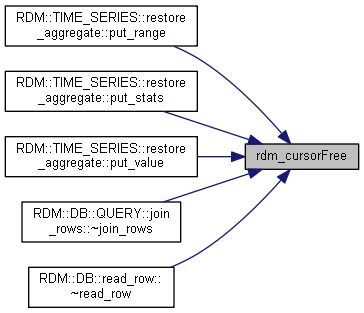
Functions |
|
| RDM_RETCODE | rdm_cursorClose (RDM_CURSOR cursor) |
| Close an RDM_CURSOR. More... |
|
| RDM_RETCODE | rdm_cursorFree (RDM_CURSOR cursor) |
| Free an RDM_CURSOR. More... |
|
Detailed Description
Cleanup API for core cursors. All the functions here are located in RDM DB Engine Library. Linker option:
-lrdmrdmSee cursor for a more detailed description of a cursor.
Function Documentation
rdm_cursorClose()
| RDM_RETCODE rdm_cursorClose | ( | RDM_CURSOR | cursor | ) |
#include <rdmcursorapi.h>
Close an RDM_CURSOR.
This function will close a cursor and free any status and row sets associated with the cursor. After a cursor has been closed it can continue to be used and associated with other row sets. Once a cursor has been freed with rdm_cursorFree() it can no longer be used.
- Locking Requirements
- None
- Return values
-
sOKAY Normal, successful return.
- See also
- rdm_dbAllocCursor
- rdm_dbGetRows
- rdm_cursorGetMemberRows
- rdm_cursorGetOwnerRow
- rdm_cursorGetRowsInReverseOrder
- rdm_cursorGetSelf
- rdm_cursorGetClone
- rdm_cursorFree
- Parameters
-
[in] cursor The cursor to be closed
rdm_cursorFree()
| RDM_RETCODE rdm_cursorFree | ( | RDM_CURSOR | cursor | ) |
#include <rdmcursorapi.h>
Free an RDM_CURSOR.
This function will free all resources associated with a cursor. Attempting to use a cursor after it has been freed may result in an application crash.
- Locking Requirements
- None
- Return values
-
sOKAY Normal, successful return.
- See also
- rdm_cursorClose
- Parameters
-
[in] cursor The cursor to be freed
- Examples
- core01Example_main.c, core02Example_main.c, core03Example_main.c, core04Example_main.c, core05Example_main.c, core06Example_main.c, core07Example_main.c, core08Example_main.c, core09Example_main.c, core10Example_main.c, core11Example_main.c, core12Example_main.c, core13Example_main.c, core15Example_main.c, core16Example_main.c, core17Example_main.c, core18Example_main.c, core19Example_main.c, core20Example_main.c, core21Example_main.c, core22Example_main.c, core23Example_main.c, core28Example_main.c, core29Example_main.c, core30Example_main.c, core31Example_main.c, core32Example_main.c, core33Example_main.c, core35Example_main.c, cpp55Example_main.cpp, cpp70Example_main.cpp, cursor/adoptChild.c, cursor/initialize_get_find_TheKing.c, cursor/insertAdults.c, cursor/insertChildren.c, cursor/insertChildrenWithSiblings.c, cursor/printAdults.c, cursor/printAdultsInReverseSortedOrder.c, cursor/printANumberOfAdultsArroundRecord.c, cursor/printANumberOfAdultsArroundRecordInSortedOrder.c, cursor/printChildNamesForMother.c, cursor/printMembers.c, cursor/printOurCommonChildrenNames.c, cursor/printParentNames.c, cursor/printSiblingNamesOnMothersSide.c, cursor/registerMembers.c, cursor/registerVoters.c, learn/bookStore_client.c, learn/bookStore_embed.c, learn/bookStore_vxWorks7.c, rtree/deleteZipcode.c, rtree/retrieveAllZipcode.c, rtree/retrieveContainedZipcode.c, rtree/retrieveExactZipcode.c, rtree/retrieveOverlapZipcode.c, and rtree/updateZipcode.c.
Referenced by RDM::TIME_SERIES::restore_aggregate< TIME_STAMP_KEY_T, SOURCE_TIME_STAMP_KEY, AGGREGATE_TIME_STAMP_KEY, NEXT >::put_range(), RDM::TIME_SERIES::restore_aggregate< TIME_STAMP_KEY_T, SOURCE_TIME_STAMP_KEY, AGGREGATE_TIME_STAMP_KEY, NEXT >::put_stats(), RDM::TIME_SERIES::restore_aggregate< TIME_STAMP_KEY_T, SOURCE_TIME_STAMP_KEY, AGGREGATE_TIME_STAMP_KEY, NEXT >::put_value(), RDM::DB::QUERY::join_rows< table_id, NEXT >::~join_rows(), and RDM::DB::read_row< table_id >::~read_row().
